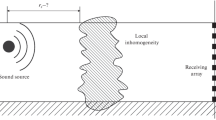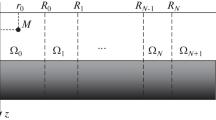Abstract
The effect of volume inhomogeneities in the sea bottom upper layer (sediments) on the long-range sound propagation in shallow water is analyzed. The experimental basis for developing inhomogeneous bottom models are the data of 3D seismic survey on the spatial structure of sediments in the Kara Sea, where variations of ~10% in the average sound speed in the bottom are observed at ranges of ~1 km. The mode coupling due to bottom volume inhomogeneities is revealed within the normal mode approach. Coupled mode equations are derived not only for propagating modes but also for leaky modes and quasimodes; including these types of modes may be urgent in analysis of the waveguides where the sound speed in the bottom (c1) is less or approximately equal to the sound speed in water (c). Numerical simulations show that the coupling between energy-carrying modes is maximum at c1 ≈ c. Calculations of the attenuation of depth-averaged sound field intensity in a water layer, performed for the Kara Sea at ranges of up to 5 km, show that the mode coupling due to bottom volume inhomogeneities can be neglected, and the depth-averaged transmission loss can be calculated using the adiabatic approximation at frequencies below a few hundred hertz. When analyzing the depth-averaged intensity, the effects of mode coupling on bottom inhomogeneities can be observed only by implementing special conditions, for example, using mode arrays providing maximally pure (free of other modes) radiation of a specified mode.











Similar content being viewed by others
Notes
There is a misprint in formula (3.143) in [2]: there must be no imaginary unit before the summation sign.
REFERENCES
V. A. Grigor’ev, V. G. Petnikov, A. G. Roslyakov, and Ya. E. Terekhina, “Sound propagation in shallow water with an inhomogeneous GAS-saturated bottom,” Acoust. Phys. 64 (3), 331–346 (2018). https://doi.org/10.1134/S1063771018030053
B. Katsnelson, V. Petnikov, and J. Lynch, Fundamentals of Shallow Water Acoustics (Springer, New York, 2012).
V. A. Grigor’ev, B. G. Katsnel’son, and V. G. Petnikov, “Determination of the absorbing and scattering properties of the sea floor in a shallow water environment by the spectra of wide-band signals,” Acoust. Phys. 47 (3), 277–281 (2001). https://doi.org/10.1007/BF03353579
V. A. Grigor’ev, A. A. Lun’kov, and V. G. Petnikov, “Attenuation of sound in shallow-water areas with gas-saturated bottoms,” Acoust. Phys. 61 (1), 85–95 (2015). https://doi.org/10.1134/S1063771015010029
A. A. Lunkov and V. G. Petnikov, “Effect of random hydrodynamic inhomogeneities on low frequency sound propagation loss in shallow water,” Acoust. Phys. 56 (3), 328–335 (2010). https://doi.org/10.1134/S1063771010030103
M. V. Volkov, V. A. Grigor’ev, I. V. Zhilin, A. A. Lunkov, V. G. Petnikov, and A. V. Shatravin, “An Arctic-type shallow-water acoustic waveguide as an information transmission channel for underwater communications,” Acoust. Phys. 64 (6), 692–697 (2018). https://doi.org/10.1134/S106377101806012X
M. V. Volkov, V. A. Grigoriev, A. A. Lunkov, and V. G. Petnikov, “On the possibility of using vertical receiving arrays for underwater acoustic communication on the Arctic shelf,” Acoust. Phys. 65 (3), 269–278 (2019). https://doi.org/10.1134/S1063771019030096
V. A. Grigoriev, A. A. Lunkov, V. G. Petnikov, and A. V. Shatravin, “Assessing the possibilities of identifying bowhead whales on the Arctic shelf,” Acoust. Phys. 65 (5), 495–506 (2019). https://doi.org/10.1134/S1063771019050099
V. A. Grigor’ev and V. G. Petnikov, “On the possibility of representing an acoustic field in shallow water as the sum of normal modes and quasimodes,” Acoust. Phys. 62 (6), 700–716 (2016). https://doi.org/10.1134/S1063771016050031
L. M. Brekhovskikh and O. A. Godin, Acoustics of Layered Media II: Point Sources and Bounded Beams (Springer Science & Business Media, 2013).
Funding
This study was supported by the Russian Foundation for Basic Research, project nos. 19-02-00127 and 14-02-00330.
Author information
Authors and Affiliations
Corresponding author
Additional information
Translated by Yu. Sin’kov
About this article
Cite this article
Grigor’ev, V.A., Lunkov, A.A. & Petnikov, V.G. Effect of Sound-Speed Inhomogeneities in Sea Bottom on the Acoustic Wave Propagation in Shallow Water. Phys. Wave Phen. 28, 255–266 (2020). https://doi.org/10.3103/S1541308X20030097
Received:
Revised:
Accepted:
Published:
Issue Date:
DOI: https://doi.org/10.3103/S1541308X20030097




